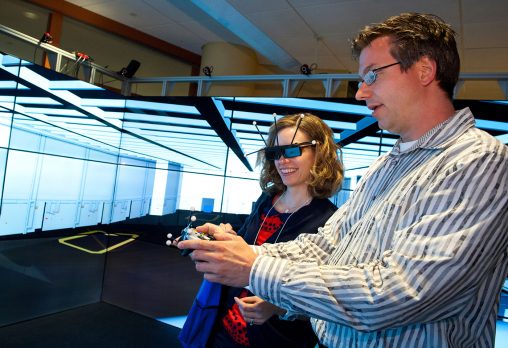
A new virtual reality system will soon be available for students and faculty to use in the Appenzeller Visualization Laboratory in the Joshi Research Center.
Wright State University students will soon be able to train for future careers on state-of-the-art virtual reality equipment.
The Advanced Visual Data Analysis (AViDA) group in the College of Engineering and Computer Science recently purchased an immersive visualization ActiveCube from Virtalis, a Kettering-based company. Virtalis is a world-leading virtual reality and advanced visualization solution provider.
The ActiveCube system is a multi-sided walkable visualization cave with floor projection. Virtalis’ Visionary Render immersive visualization software platform will be used to support job training and drive future technologies at Wright State.
The virtual reality system will help teach Wright State students everything from anatomy to science and engineering.
“The system tracks where you are and recreates your perspective, so it feels like you are really walking through the virtual world,” said Thomas Wischgoll, professor of computer science and engineering and director of the AViDA group.
The system will be available early next year to every college at Wright State. Students and faculty from psychology and human factors have already expressed interest in using the equipment, which will be available for research projects and education in the Appenzeller Visualization Laboratory in the Joshi Research Center.
The new equipment will be important in training students for jobs following graduation. Several local companies frequently use virtual reality. Some of the virtual reality equipment, for instance, will be used to train future welders, saving on the cost of buying actual welding tools and making for safer training.
The new technology will expose students to a virtual environment where they can see things such as the inner workings of an automobile or the human body without having to disassemble a vehicle or operate on a patient. It will also turn large amounts of data into images to enhance learning comprehension.
Multiple people can be immersed in the display at the same time, enabling them to interact with each other.
“From an instructional perspective you can use it to explain things to other people,” Wischgoll said. “Students can see what you see.”

Thomas Wischgoll, director of the Advanced Visual Data Analysis group in the College of Engineering and Computer Science, showing a head-mounted virtual reality display in the Appenzeller Visualization Lab.
Wright State received $538,562 in funding from the Ohio Department of Higher Education to purchase the system. The state funds are part of the Ohio Department of Higher Education’s Regionally Aligned Priorities in Delivering Skills (RAPIDS) program, which seeks to provide the most up-to-date education possible to create a skilled workforce for in-demand jobs.
“We are thankful for the funding from the RAPIDS program that is allowing us to add the ActiveCube system,” said Brian Rigling, interim dean of the College of Engineering and Computer Science. “The Appenzeller Visualization Lab is an exceptional resource for training, education, and research in the Dayton region, and I admire Robert Appenzeller’s vision in helping to establish it for the benefit of Wright State and our community partners.”
AViDA is dedicated to research and support of the community in scientific and information visualization, medical imaging and virtual environments. The group runs and supports the Appenzeller Visualization Laboratory. The $2 million Vis Lab opened in 2007, enabling businesses to outsource virtual reality work without having to buy the technology themselves.

 Wright State alum Lindsay Aitchison fulfills childhood space-agency dream
Wright State alum Lindsay Aitchison fulfills childhood space-agency dream  Wright State business professor, alumnus honored by regional technology organizations
Wright State business professor, alumnus honored by regional technology organizations  Wright State University Foundation awards 11 Students First Fund projects
Wright State University Foundation awards 11 Students First Fund projects  Gov. DeWine reappoints Board Treasurer Beth Ferris and names student Ella Vaught to Wright State Board of Trustees
Gov. DeWine reappoints Board Treasurer Beth Ferris and names student Ella Vaught to Wright State Board of Trustees  Joe Gruenberg’s 40-Year support for Wright State celebrated with Honorary Alumnus Award
Joe Gruenberg’s 40-Year support for Wright State celebrated with Honorary Alumnus Award 